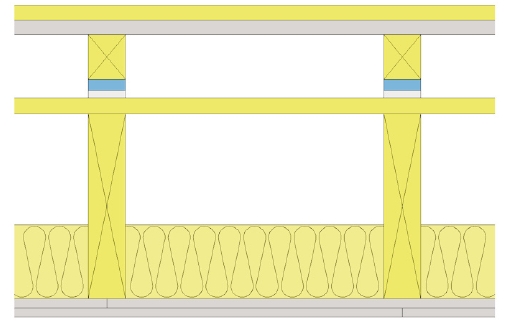Resilient batten
The term ‘batten’ generally refers to a strip of timber (although it can also be steel or plastic) used in the construction of buildings. Battens are typically used as spacers to raise the surface of a material, or as a secondary framework onto which a surface may be fixed. Battens are used in the construction of roofs, walls, floors, ceilings and a number of other applications.
According to 'Housing and sound insulation, Improving existing attached dwellings and designing for conversions', published in 2006, the term 'resilient batten' refers to a timber batten with a resilient layer that can be placed under floor surfaces to reduce impact sound.
A resilient layer is a layer that isolates an element (such as screed or a floating floor) from another element (such as the base floor). Generally, the resilient layer is pre-bonded beneath the batten (although it is sometimes on top of the batten). It may be formed using foams, cellulose compounds or fibrous polyesters, and may use two or more densities or compounds of material, with different compositions giving different degrees of performance. For example, a 65–90mm system installed at 400 centres might give an airborne improvement of 8–12dB and an impact improvement of 12–18dB.
Resilient battens must be installed onto a flat surface and not directly laid onto joists or ribbed structures. Where there are timber joist floors, the resilient battens should be placed on a sub-deck board. It is important to ensure fixing tween the for flooring board to batten do not penetrate into the resilient layer.
Approved document E: Resistance to the passage of sound, 2003 edition incorporating 2004, 2010, 2013 and 2015 amendments, states: ‘A floating floor consists of a floating layer and resilient layer.” Where a floating layer is: ‘A surface layer that rests on a resilient layer and is therefore isolated from the base floor and the surrounding walls.” And a resilient layer is: ‘A layer that isolates a floating layer from a base floor and surrounding walls.”
[edit] Related articles on Designing Buildings
Featured articles and news
Ebenezer Howard: inventor of the garden city. Book review.
The Grenfell Tower fire, eight years on
A time to pause and reflect as Dubai tower block fire reported just before anniversary.
Airtightness Topic Guide BSRIA TG 27/2025
Explaining the basics of airtightness, what it is, why it's important, when it's required and how it's carried out.
Construction contract awards hit lowest point of 2025
Plummeting for second consecutive month, intensifying concerns for housing and infrastructure goals.
Understanding Mental Health in the Built Environment 2025
Examining the state of mental health in construction, shedding light on levels of stress, anxiety and depression.
The benefits of engaging with insulation manufacturers
When considering ground floor constructions.
Lighting Industry endorses Blueprint for Electrification
The Lighting Industry Association fully supports the ECA Blueprint as a timely, urgent call to action.
BSRIA Sentinel Clerk of Works Training Case Study
Strengthening expertise to enhance service delivery with integrated cutting-edge industry knowledge.
Impact report from the Supply Chain Sustainability School
Free sustainability skills, training and support delivered to thousands of UK companies to help cut carbon.
The Building Safety Forum at the Installershow 2025
With speakers confirmed for 24 June as part of Building Safety Week.
The UK’s largest air pollution campaign.
Future Homes Standard, now includes solar, but what else?
Will the new standard, due to in the Autumn, go far enough in terms of performance ?
BSRIA Briefing: Cleaner Air, Better tomorrow
A look back at issues relating to inside and outside air quality, discussed during the BSRIA briefing in 2023.
Restoring Abbotsford's hothouse
Bringing the writer Walter Scott's garden to life.
Reflections on the spending review with CIAT.
Retired firefighter cycles world to raise Grenfell funds
Leaving on 14 June 2025 Stephen will raise money for youth and schools through the Grenfell Foundation.
Key points for construction at a glance with industry reactions.























